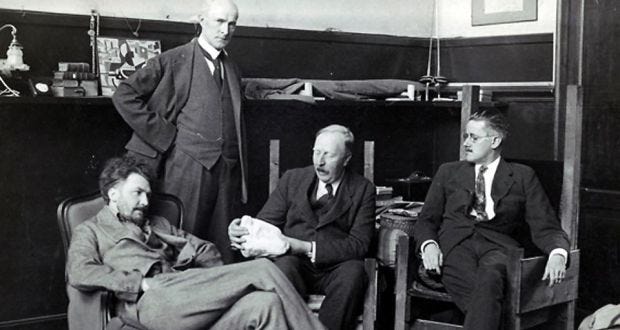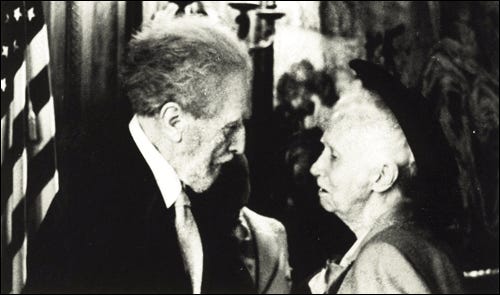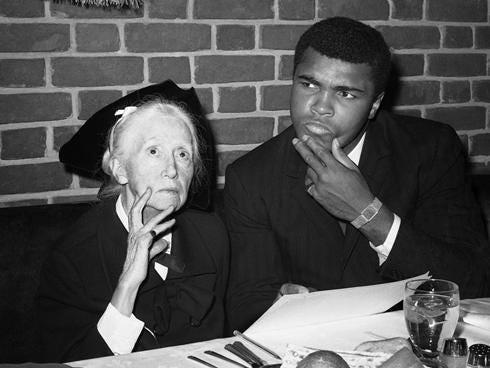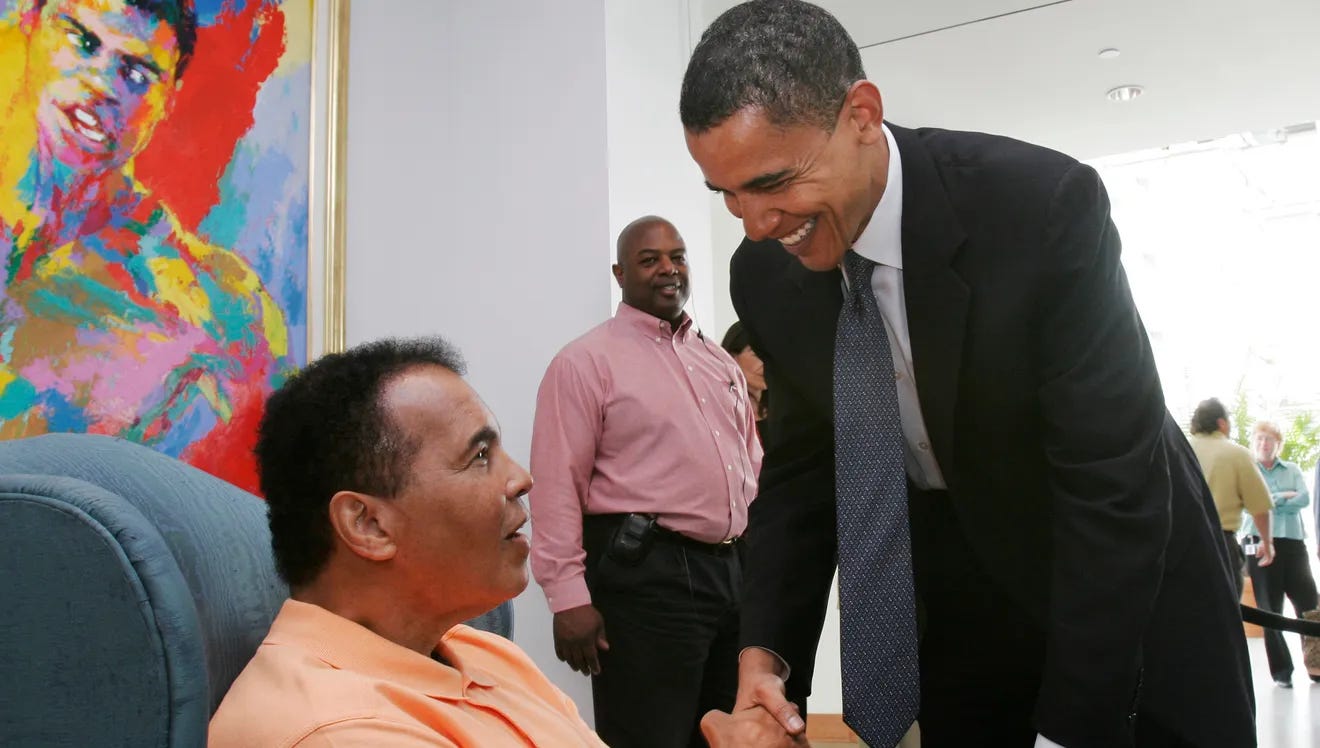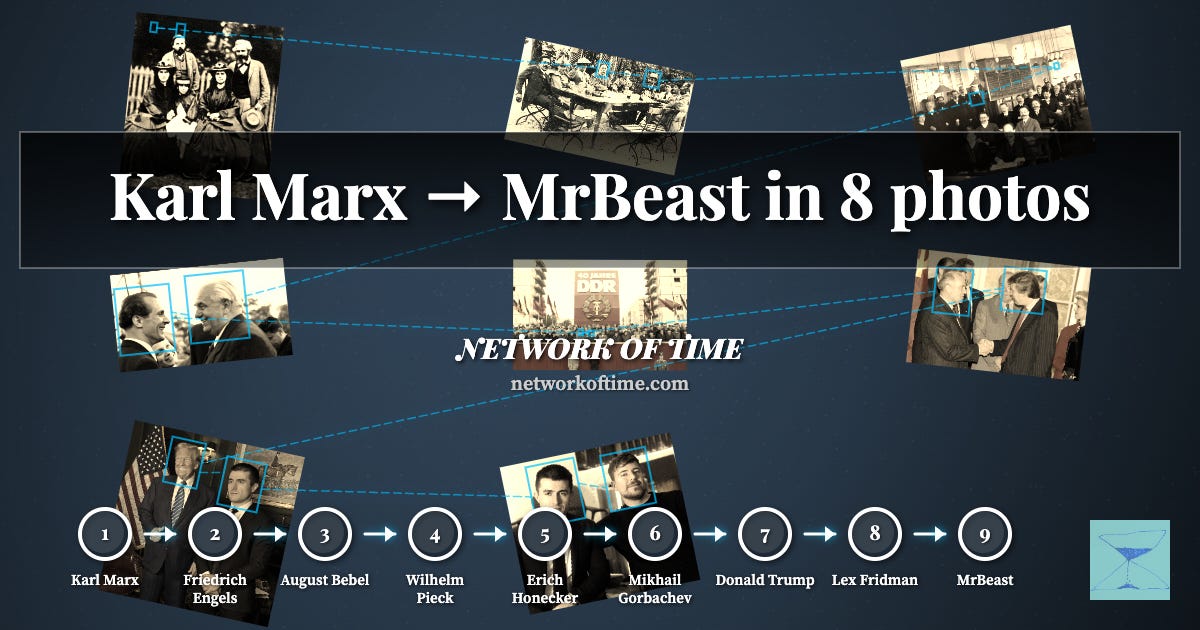You’re in the Network Of Time
Introducing the first platform for exploring degrees of separation in photos
Every photo you take with someone else links you into the vast network of people caught together in images.
It’s a collage millions of pictures deep – every actor you’ve seen on screen, every politician you’ve seen in the news, almost everyone you’ve seen in a history textbook.
Network Of Time is the world’s first interactive snapshot of this network.
Proof you are connected to everyone
At networkoftime.com, you can search or browse for any two people in the network, and see how they can be connected through real photographic encounters.
You can browse famous people, trace connections between historical figures, search for yourself, or add new photos. Every image builds out the map.
As of today, the website has 12,000+ verified photos featuring 16,000+ unique people, all traceable to each other.
The network includes people from every UN country, so whether you're exploring connections through Bollywood stars, African Nobel laureates, or European philosophers, you can filter by country of birth to start with figures from wherever you are.
The website unfolds the last 181 years of photographed history – making abstract relationships tangible, showing real bridges across international cultures, and proving human continuity.
Think of any two well-known people from the last couple centuries, separated by time and place.
You might think of names like “Barack Obama” and “James Joyce” – a US President and an Irish literary radical, separated by a century.
You can connect them through surprisingly few interactions.
In 1924, Joyce (at extreme right) was photographed with Ezra Pound (at extreme left) in Pound’s Paris studio.
In 1969, Pound was shot in New York City with Marianne Moore. The two met at the 35th anniversary reception of the Academy of American Poets.
Three years earlier, also in New York, Moore met Muhammad Ali – then Cassius Clay – at Toots Shor’s restaurant. They were introduced by Paris Review founder George Plimpton.
And in 2006, Ali met Senator Barack Obama on a trip to the Muhammad Ali Center in Louisville, Kentucky.
This is just one of millions of connections you can trace right now.
You can go ahead and see how Karl Marx connects to MrBeast in 8 meetings, or Friedrich Nietzsche to Charli D'Amelio in 7, and generate an absurd graphic like this one to share with friends.
Why I created the Network Of Time
Being in the frame with someone else does something to you.
When our loved ones are gone, we look back at our pictures together to feel closer to them.
People spend money at conventions to get a quick picture beside someone appearing in a film they love, just to be included among the images they admire.
Pictures can help us feel connected to the world.
But they can also be alienating, like we’re drowning in images with no thread to pull ourselves along through them.
Most days, scrolling through your phone, you see images of hundreds of people.
Friends, world leaders, entertainers, microcelebrities, strangers.
Our feeds fracture our sense of time and place, showing us so many people without showing the connections between them.
Our personalized content increasingly displaces us from consensus reality.
The Network Of Time is the first real proof that everyone alive today – and thousands of people going back to the 19th century – can be connected through real photographs, usually in fewer than 10 steps.
Now, you can explore photographs as a bridge between worlds, and not just moments stuck in time.
To create the platform, I manually verified more than 11,000 photos featuring 15,000+ people and built an engine for exploring degrees of separation between everyone.
Each photo is cross-referenced with its original source, and tagged with location, date, and identification metadata where available. I prioritize images from public archives, Creative Commons sources, and news photography.
There is guaranteed to be someone whose connection to you becomes easy to understand, or maybe even someone who you already have a photo with.
Most current world leaders are present – documented further, the network would reveal these world leaders with state and provincial leaders, then local and regional leaders, then local community members and their families.
Hundreds of people are included on the Network from Wikipedia’s list of vital articles, so you can connect Virginia Woolf to Tupac, or Kahlil Gibran to Vincent van Gogh.
You can also connect historical figures like Abraham Lincoln or Charles Darwin to the TikTok stars of today, if you want to really make the past feel real in a history classroom.
Billions of people could eventually be added, so there are glaring omissions in notable people and photos.
The connection paths are not always chronological, and connections occasionally are tenuous. (You might encounter an anticlimactic photo of a Knicks game halftime in February 2020 where Jesse Jackson was on the court so I rushed to snap a blurry pic with my thumb in the frame just to link us.)
But everything is real.
Seeing improbable connections produces a kind of awe – like the veil is lifting over our hidden interdependence.
I created the Network Of Time as a tool to help people feel connected. I already use it daily as a kind of serendipity engine.
Now, you can connect people that seem unrelated.
If I read an essay where someone references, for example, NAACP co-founder Ida B. Wells – and she’s a cultural blind spot for me – I run a match between myself and Wells in the Network.
It shows:
I appear in the background of a 2017 town hall talk by Canada’s then-Prime Minister Justin Trudeau.
Trudeau shaking hands with Microsoft CEO Satya Nadella at the World Economic Forum in 2018.
Nadella with entrepreneur Robert G. Clark in 2024 at the Executives’ Club of Chicago.
A recent photo of Clark with his friend, late architect Gyo Obata.
Obata, circa 1960, meeting Illinois industrialist Arnold H. Maremont.
Maremont at a press conference in 1954 with Rev. Carl A. Fuqua, who was executive director of the Chicago NAACP.
Fuqua in 1963 presenting a portrait of Ida B. Wells to her daughter Alfreda Duster.
Alfreda Duster as a child in 1909 with her siblings and mother, Ida B. Wells.
Suddenly, Ida B. Wells isn’t abstract to me – we are in the same world, and I see how.
It makes sense: I saw my country’s Prime Minister, who met global CEOs, who met international business leaders, who had brilliant colleagues, who worked with community leaders.
The chain grounds you, in Chicago or anywhere.
And notably, this kind of connection – spanning generations, rooted in photographs – is something AI still struggles to recognize.
What AI doesn’t understand about social history (yet)
The Network Of Time enables a totally novel method to trace a fragment of the social history of the last 170 years.
As more photos and people are added to the network, and it densifies and expands, new undocumented connections and trends are revealed.
Acknowledging the limits of the project’s current scope: the dataset is a goldmine for researchers, capable of answering questions about the historic social graph that AI currently can’t handle.
This will be due to models’ current information-gathering abilities, and understandable safeguards when it comes to questions around people where they don’t have 100% confidence in their underlying connections.
As a test, I asked three leading AI models whether it is hypothetically possible to connect Alfred, Lord Tennyson – a Victorian poet born at the turn of the nineteenth century – with TikTok star The Rizzler (b. 2016), through co-appearances in photographs with other people.
They all said this is totally or virtually impossible.
The prompt: “Is it even hypothetically possible to connect The Rizzler to Alfred, Lord Tennyson through co-appearances in multiple photographs, where The Rizzler was photographed with person A who was photographed with person B, etc., up until a photograph that features Alfred, Lord Tennyson?”
Claude: “[…] So no, it's not even hypothetically possible given the constraints of photographic history and the timeline involved.”
ChatGPT: “No, there is no plausible or documented photographic chain connecting Alfred, Lord Tennyson to The Rizzler. The vast historical, technological, and generational distances—plus the limited archival overlap—make such a connection purely hypothetical fiction.”
Gemini: “In essence, while theoretically possible due to the overlapping lives and photographic habits of humans across generations, practically constructing and verifying such a chain would be an immense, perhaps impossible, undertaking.”
But you can follow this link to see a sourced chain from Alfred, Lord Tennyson to The Rizzler in six photos:
Lord Tennyson with his son Hallam in the mid-19th century.
Hallam with George V (then Duke of York) in 1901 after he became Governor of Adelaide.
George V with the Royal Family including baby Elizabeth II at her christening in 1926.
QEII with President Trump on a trip to Windsor Castle in 2018.
Trump on Jimmy Fallon in 2015.
The Rizzler reviewing Halloween candy with Costco Guys AJ and Big Justice on Fallon in 2024.
While this is a frivolous example, I encourage you to think about the implications of large language models completely misunderstanding how these chains are possible.
Imagine if these LLMs, with the analytical power they hold and their existing datasets, also had access to a massive, human-verified, provenance-rich social graph.
With tools for traversing a transparent and public social graph added to their toolset, they could provide incredible insights about history and help us understand elements of our collective past in a non-linear way that has been impossible until now.
And they could help us understand how influence moves along spheres of global culture and power in ways that are only hypothetical without visual evidence.
The Network Of Time can already help you trace connections between international art that would be extremely time-consuming to figure out otherwise, like a surreal Google Maps Directions but for culture. (Probably no one living could tell you how to get from Japanese electropop musician aaamyyy to South African rapper Zoocci Coke Dope, but now you can easily find a path via DJ Khaled in the Oval Office and ASAP Ferg on Hot Ones.)
What’s next?
I first launched the Network Of Time in 2019 with a slow prototype – it took about a minute just to load one connection.
I built it because it felt like it should exist as something exciting people could stumble upon. After a quiet launch, I moved on.
It sat dormant until late 2024, when it unexpectedly started getting attention – first with a prominent feature in the Internet Is Beautiful newsletter, then on John August’s Scriptnotes podcast, where Jesse Eisenberg said, “Oh my God, this is amazing,” after matching himself with Shakira.
That response – and what I’ve learned since – convinced me to rebuild it from the ground up.
This new version loads connections in one second, lets you explore deeper with annotations and deep chain explorations, and is ready for user contributions.
I am going to keep adding photos, approving user submissions, and writing here about what I learn.
If you’re interested in this kind of social history, subscribe to the Substack – I’ll publish regularly about things like:
The surprising challenges of adding certain people
Weird, obscure, photos of US presidents
Network structure: density, betweenness, and patterns of influence
The most unexpected places I’ve found myself in images online including: on stage with Salt N Pepa, with multiple Canadian federal party leaders, and in a Riff Raff music video
If you are in the digital humanities, an AI researcher, journalist, or anyone curious about this project – please reach out to me at jesse@networkoftime.com, I would love to connect with you.
Finally, I must acknowledge the current representation of the Network is biased towards my own interests and cultural context. What I’m saying is, you’re going to see a deeply disproportionate amount of Nova Scotians.
But the site includes a “Submit” feature – you can add yourself, or any public domain or Creative Commons photos of notable people. I will manually verify all user submissions daily until I have to scale that out.
I encourage you to login and add photos of yourself and your family so when a user hits the “random person” button, they are equally likely to explore history starting from either Charles Dickens or your grandma. Let’s see what happens.
Jesse Ward is a professional open source intelligence trainer and speaker, award-winning journalist and comedian, and web developer based in Lunenburg, Nova Scotia. He is the creator of the Network Of Time.

